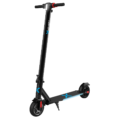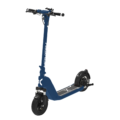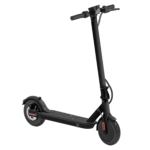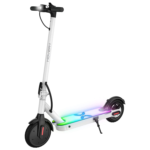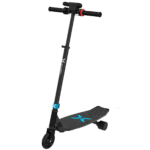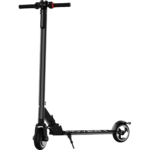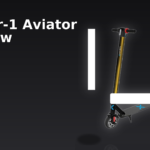- Home
- Scooters
- Electric Scooters
- Hover-1 Edge 2.0
Hover-1 Edge 2.0


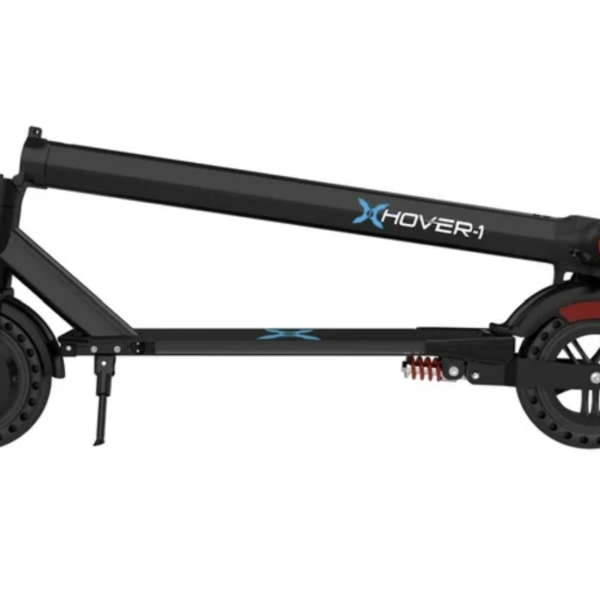
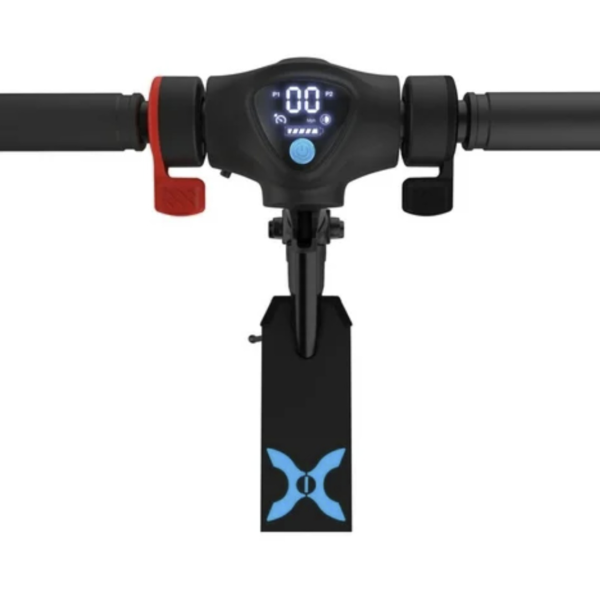
- Battery Range: 6 miles (10 km)
- Top Speed: 15 mph (24 km/h)
- Motor Power: 350 W
- Weight Capacity: 264 lb (119.7 kg)
- Charging Time: 5 h
- Scooter Weight: 25.1 lb (11.4 kg)
PROS
- 15 mph (24 km/h) top speed
- 8″ solid tires and rear shock
- Deck light + LCD display
- Portable 25.1 lb (11.4 kg) weight
CONS
- Range limited to 6 miles (10 km)
- Basic braking (electronic + foot)
- No smartphone app
- IP rating not specified
Table of contents
- What Is the Hover-1 Edge 2.0?
- How the Hover-1 Edge 2.0 Works
- Key Specifications
- Design & Build Quality
- Performance Fundamentals
- Battery, Range & Efficiency
- Ride Quality & Comfort
- Braking & Safety Features
- Portability & Daily Usability
- Maintenance & Care
- Weather & Seasonal Considerations
- Hover-1 Edge 2.0 vs Alternatives
- Who the Hover-1 Edge 2.0 Is (and Isn’t) For
- FAQs
- Glossary
- Closing Thoughts
The Hover-1 Edge 2.0 is a compact, beginner-friendly electric scooter built for short urban trips and campus hops. It mixes a 350W brushless hub motor, solid 8-inch tires, and a practical folding design that fits tight spaces. If you’re cross-shopping larger long-range models like the Xiaomi Electric Scooter 4 Pro Max, this overview will help you understand where the Edge 2.0 fits. If you need a simple last-mile ride with clear controls and low upkeep, the Hover-1 Edge 2.0 lands squarely in that sweet spot.
What Is the Hover-1 Edge 2.0?
The Hover-1 Edge 2.0 is a folding, single-rider e-scooter designed for paved, even surfaces. It emphasizes simplicity and daily convenience over raw power. You get two speed modes, a clear LCD display, an electronic brake paired with a rear foot brake, and useful touches like a headlight, deck lighting, a kickstand, and a Bluetooth speaker for low-volume music or safety prompts. Moreover, the chassis keeps weight down to about 25.1 lb (11.4 kg), so most riders can lift it into a trunk or up a few stairs without strain.
This model targets short commutes and quick errands. Because it keeps components straightforward, the learning curve is gentle. New riders typically get comfortable within a few minutes of practice, especially with the kick-to-start behavior that prevents sudden launches. Even so, the Edge 2.0 isn’t built for steep hills or long-distance touring. Instead, it handles what many riders actually need: steady cruising on neighborhood streets, campus paths, and bike-lane-friendly routes.
How the Hover-1 Edge 2.0 Works
Think of the Edge 2.0 like a bicycle with a booster. Your thumb tells the controller how much power to send; the controller then feeds the brushless hub motor smoothly, so acceleration feels predictable. Here’s the basic anatomy:
- Motor: A 350W brushless hub motor sits inside one wheel. Brushless motors are efficient and quiet, so you’ll hear more road noise than motor whine.
- Controller: This is the scooter’s “brain.” It takes throttle input and battery status, then meters power to the motor. It also commands the electronic brake and manages speed modes.
- Battery: A 36V, 4Ah (≈144Wh) lithium-ion pack supplies power. Capacity is modest by design, which keeps weight and charge times down.
- Throttle: A thumb throttle on the right handlebar provides linear control. Because the scooter is kick-to-start, you nudge it forward first, then apply throttle.
- Brakes: The left lever activates electronic braking (motor-based deceleration). A rear foot pedal adds mechanical braking to slow the wheel even if the electronics are off.
Together, these parts behave like a well-coordinated team. You kick, press the throttle, and the controller brings in power smoothly. When you want to slow down, you feather the electronic brake and add the foot brake as needed. As a result, the process stays intuitive even if it’s your first time on an e-scooter.
Key Specifications
| Block | Details |
|---|---|
| General | Model: DSA EDGE (Hover-1 Edge 2.0); Net weight: 25.1 lb (11.4 kg); Rider weight range: 44–264 lb (20–120 kg); Single-rider use; Folding electric scooter. |
| Performance & Power | 350W brushless hub motor; Speed modes: P1 9 mph (15 km/h), P2 15 mph (24 km/h); Kick-to-start assist. |
| Battery, Charging & Electrical | 36V 4Ah (≈144Wh) lithium-ion; Charge time up to 5 hours; Charger input AC 100–240V, 50/60 Hz; LCD display; Safety alerts; Headlight and deck lighting. |
| Build & Dimensions | Open size: 40.8 × 17.3 × 46.3 in (103.8 × 44 × 117.6 cm); Folded size: 40.8 × 17.3 × 16.7 in (103.8 × 44 × 42.5 cm); Tires: 8 in solid (non-pneumatic) front & rear; Rear shock absorber; Kickstand. |
| Safety & Control | Brakes: Electronic (regen feel) + rear foot brake; Two speed modes; Kick-to-start; Headlight + deck light. |
| Features & Extras | LCD display, Cruise Control, Bluetooth speaker, folding latch, kickstand. |
| Warranty & Compliance | Limited 90-day parts & labor warranty; UL2272 certification; FCC ID noted in documentation. |
These specifications reflect the official data; unit conversions appear in both US and metric to streamline comparison.
Design & Build Quality
The frame is lightweight aluminum, which keeps mass down and resists corrosion. The stem is slender but not flimsy; it locks into a compact folded package with the deck clip. Because the scooter uses solid 8-inch tires, the sidewalls include molded honeycomb channels that flex slightly over small debris. Consequently, this choice trades the plush feel of air-filled tires for low maintenance and puncture immunity.
The deck is slim and long enough for an average stance. Although it’s not a large platform, foot placement feels natural once you settle with your dominant foot forward. Meanwhile, the rear shock absorber adds a bit of give over expansion joints and rough paint lines. It won’t float over deep potholes, but it helps take the edge off chatter that small wheels would otherwise pass straight to your legs.
Up top, the LCD display sits at the center of the cockpit. It shows speed, battery bars, cruise control, and headlight status. The power/function button handles power-on, lights, and mode toggles. The left lever engages the electronic brake, while the right thumb throttle controls drive. Additionally, the wiring stays neat, and the plastics feel consistent for the class. Fit-and-finish is clean, with no rattly body panels when everything’s tightened correctly.
Performance Fundamentals
Acceleration feel: From a gentle kick-off, the motor brings in power smoothly. It won’t snap forward like a high-wattage commuter scooter, and that’s the point. New riders appreciate the confidence that comes from predictable ramp-up, especially in P1. Then, switch to P2 when you want to cruise at neighborhood speeds without surges.
Cruising stability: On flat pavement the Edge 2.0 tracks straight and feels planted. Small solid tires like to ride best on clean surfaces, so you’ll feel seams and sharp cracks more than with large pneumatic wheels. Even so, the deck’s height and the short wheelbase help the scooter feel nimble, yet it remains settled at its top speed.
Hill-climb behavior: On gentle grades, the motor maintains pace with modest input. On ~7–10% neighborhood hills, expect speeds to drop and acceleration to slow. Because the motor is 350W and the battery is 36V, the system favors efficiency over brute torque. Therefore, plan your route with that in mind, and carry a bit of speed into steeper sections.
Battery, Range & Efficiency
The 36V, 4Ah (≈144Wh) pack aligns with the scooter’s compact role. In ideal conditions and a conservative speed mode, the rated up to 6 miles (10 km) is achievable. In practice, real-world range varies because rider weight, rolling resistance, wind, surface roughness, elevation, and stop-and-go patterns all influence energy use.
To maximize range:
- Ride in P1 when you don’t need full speed.
- Keep throttle steady. Cruise control helps hold a constant pace above 3 mph (5 km/h).
- Avoid repeated hard starts. Kick to start, then roll on the throttle.
- Mind temperature. Lithium-ion cells deliver less at near-freezing temps.
- Keep tires clean. Even solid tires pick up debris that saps momentum.
Charging is straightforward. Expect up to 5 hours from low battery to full, depending on the last few percent. The final top-off always moves slow to balance the pack. For daily care, top-ups during a workday or class block are practical, especially if you charge near 40–80% for most cycles to reduce stress on the cells.
Storage matters too. If you’ll park the scooter for weeks, leave the battery around 50–60%, store it in a cool, dry place, and reconnect the charger once every month or two to prevent deep discharge. Thus, you preserve long-term health.
Ride Quality & Comfort
Solid tires mean no flats and no pumps, which many riders love. However, you will feel sharper edges more than with tubed tires. The small rear shock softens repetitive vibration and helps the rear wheel stay in contact over ripples. It’s not a full suspension setup, so approach rough patches with bent knees and relaxed arms. This stance takes load off the handlebar and keeps the scooter settled. As a bonus, it also reduces wrist fatigue.
Ergonomics are user-friendly. The throttle throw is short enough for fine control without cramping your thumb on longer rides. Furthermore, the deck coating grips well, and the headlight improves low-light visibility directly ahead. Because the stem is slim, you may notice a touch of flex if you brace hard over a bump; keep fastener checks on schedule and avoid curbs to minimize stress.
Braking & Safety Features
The Edge 2.0 uses a dual-system approach:
- Electronic brake (regen feel): Activated by the left lever, it slows the motor smoothly. This is ideal for feathering speed on descents or before turns.
- Rear foot brake: Press your foot down on the rear fender to add mechanical braking. This is your stronger stop and remains available even if the display is off.
Together, they deliver predictable stops with a short learning curve. Practice progressive pressure, and avoid stamping on the foot brake, which can lock a solid wheel on slick paint lines. Meanwhile, the headlight increases your conspicuity at dusk, while the deck light adds visibility from the side. The scooter’s manuals advise against water exposure and riding in rain, so treat wet surfaces as off-limits.
The LCD also displays safety alerts for low battery and overheating. If you see warnings, stop and let the scooter rest or charge as indicated. In most cases, a short pause restores normal function.
Portability & Daily Usability
At 25.1 lb (11.4 kg), the Edge 2.0 is easy to carry for short stretches. The folding latch drops the stem to the deck clip, creating a compact package: 40.8 × 17.3 × 16.7 in (103.8 × 44 × 42.5 cm). Consequently, it slides behind a desk, under a café table, or into a hatchback with room to spare.
Because the deck is slim, boarding and dismounting feel natural. The kickstand flips down quickly, and the kick-to-start logic reduces accidental throttle launches in crowded areas. In addition, cruise control helps on longer straightaways: hold a steady speed above 3 mph (5 km/h), double-press the throttle, and listen for the confirmation beep. Tap brake or throttle to exit.
For daily security, lean on layered habits rather than brute force. Bring the scooter inside when possible. If you must lock outside, choose a visible rack, loop a lightweight lock through the stem and a fixed point, and keep dwell times short. Ultimately, the Edge 2.0’s portability is your best anti-theft tool.
Maintenance & Care
Although solid tires cut upkeep, routine checks keep the Edge 2.0 feeling tight and safe. Use this simple schedule:
- Before each ride: Quick walk-around. Confirm latch engagement, brake function, headlight, and deck light. Check for unusual play at the stem hinge.
- Weekly (or every ~30–40 miles / 50–65 km): Inspect wheel fasteners, rear fender screws, and handlebar clamp bolts. Wipe dust and check for debris lodged in tire channels.
- Monthly: Re-torque hinge hardware, clean the charging port cap, and verify the kickstand bolts. Lightly test the foot brake for friction and return spring feel.
- Every 3 months: Do a deeper fastener audit along the steering column and deck hardware. The manual diagrams the screw points—work top to bottom so you don’t miss one.
- Battery care: Keep it between 20–80% for daily use when possible. Avoid heat. If you store the scooter, leave the battery about half full and top up periodically.
Avoid pressure washing or soaking the scooter. Instead, use a slightly damp cloth for the frame and a dry brush for the tires and deck grip. Afterward, let everything dry before you ride again.
Weather & Seasonal Considerations
This scooter has no stated IP rating, and the documentation advises against riding in rain, snow, or through puddles. Water can infiltrate bearings, switches, and the battery enclosure, which risks damage. Therefore, plan routes and timing with weather in mind.
In hot weather, park in the shade and avoid charging immediately after a long ride. In cold weather, range drops as chemistry slows. Pre-warm the scooter indoors, then head out. Because solid rubber hardens in the cold, braking distances can increase; ride slower and brake earlier. Likewise, use smooth throttle to avoid wheel spin on painted lines.
If you get caught by a sprinkle, dismount and carry the scooter to shelter. Then, let it dry before your next ride. Moisture plus dust forms grime that can bind hinges and controls, so wipe everything down after exposure.
Hover-1 Edge 2.0 vs Alternatives
Within entry-level scooters, you’ll find three broad groups:
- Kids / youth models: Very low top speeds and tiny batteries. The Edge 2.0 surpasses them with adult-friendly ergonomics, better lights, and sturdier hardware.
- Basic commuters: Heavier frames, bigger batteries, and sometimes air-filled tires. Those models ride softer and climb better, yet they’re harder to carry and stow.
- Performance / off-road machines: Far more motor power and suspension travel. They rip on hills and rough paths, but they cost more, weigh much more, and demand frequent checks.
The Hover-1 Edge 2.0 excels when you want a light, simple, and foldable scooter for short rides. If your route demands longer range, repeated steep hills, or rough pavement, a higher-capacity commuter with larger pneumatic tires will serve you better. However, for apartment dwellers and students who prize portability and low maintenance, the Edge 2.0’s formula is exactly right.
Who the Hover-1 Edge 2.0 Is (and Isn’t) For
Great for:
- Students and campus staff hopping between buildings.
- Apartment dwellers who need easy indoor storage.
- Multi-modal commuters connecting train or bus to the last mile.
- New riders who want calm acceleration and simple controls.
- People who hate flat tires and prefer plug-and-play upkeep.
Not ideal for:
- Riders needing daily 10+ mile (16+ km) round trips without charging.
- Hilly neighborhoods with long >10% grades.
- Rough-surface routes full of broken asphalt or curbs.
- Riders who want plush suspension or high top speeds.
FAQs
1) How fast does it go, and can I limit speed for new riders?
Top speed is up to 15 mph (24 km/h) in P2. Use P1 to cap speed around 9 mph (15 km/h) while learning.
2) What kind of range should I expect day to day?
The rated range is up to 6 miles (10 km). Real-world range varies with weight, temperature, surface, elevation, and stop-and-go patterns. Consequently, plan a margin.
3) Does the Hover-1 Edge 2.0 have cruise control?
Yes. Hold a steady speed above 3 mph (5 km/h) and double-press the throttle. Tap brake or throttle to exit. Conveniently, it reduces thumb fatigue.
4) Can I ride in light rain or through puddles?
No. There’s no official IP rating listed, and the documentation warns against water exposure. Therefore, ride on dry, clean surfaces.
5) How does the braking feel?
Electronic braking is smooth and predictable. Add the rear foot brake for stronger stops. With practice, progressive pressure becomes second nature.
6) What tires does it use, and do I need to pump them?
It uses 8-inch solid (non-pneumatic) tires, so you’ll never pump or patch them. However, expect a firmer ride than air-filled options.
7) Where can I find a concise Hover-1 Edge 2.0 overview?
Right here. This article summarizes design, features, performance, care, and official data in one place.
Glossary
- Ah (amp-hour): Battery capacity. Higher Ah generally means more stored energy.
- Wh (watt-hour): Voltage × capacity; a clearer measure of total energy.
- Brushless hub motor: Efficient motor built into the wheel for quiet drive and low upkeep.
- Controller: The electronic unit that meters power from battery to motor based on throttle input.
- Kick-to-start: You push off first; throttle activates only after motion begins.
- Regen (regenerative feel): Motor braking that converts motion back into electrical resistance for smooth deceleration.
- Stem flex: Small fore-aft movement in the handlebar post over bumps; common on lightweight scooters.
- IP rating: Ingress Protection; a formal water/dust rating. None is listed here.
- UL2272: A safety certification for electrical systems in rideables.
- Solid (non-pneumatic) tire: Rubber tire without air; puncture-proof but firmer ride.
- Torque: Rotational force from the motor; helps with starts and hills.
- Cruise control: Maintains a constant speed until you brake or adjust throttle.
- Electronic brake: Uses the motor to slow the wheel; smooth and low-wear.
- Foot brake: Mechanical braking by pressing the rear fender; adds stopping power.
- Speed mode: Preset limits for acceleration and top speed.
- Specifications: The official set of measurements and features for a product.
Closing Thoughts
The Hover-1 Edge 2.0 keeps things refreshingly simple. You fold it fast, carry it easily, and learn the controls in minutes. It’s not built to conquer rough streets or huge hills, yet it shines on smooth pavement with short-to-medium hops. If you want an approachable, low-maintenance e-scooter that covers daily errands or campus loops without fuss, the Edge 2.0 is a sensible pick. In short, it does the basics well and avoids unnecessary complexity.
Specifications
General
| Model The Model specifies the exact version or name of the scooter. It helps identify its unique design, features, and specifications within the manufacturer’s product line. Knowing the model makes it easier to compare options, find compatible accessories, or look up support information. | Edge 2.0 |
| Brand The Brand identifies the manufacturer or company that designs and produces the scooter. A trusted brand is a sign of quality, reliability, and good customer support. Well-known brands often have higher standards for safety, performance, and after-sales service, giving you more confidence in your purchase. | Hover-1 |
| Release Date The Release Date indicates when the scooter model was officially launched on the market. This helps you know how current the design, technology, and features are. A newer release date often means updated components, improved performance, and the latest safety or smart features. | 17 November 2025 |
| Recommended Age Recommended Age indicates the minimum age range that the scooter is designed for, based on safety, size, and ease of use. Following the recommended age helps ensure that riders can handle the scooter’s speed, weight, and controls comfortably and safely. Always check local laws and use protective gear, especially for younger riders. | 12+ |
Performance & Power
| Motor Power (Wattage) What it means: The motor power, measured in watts (W), shows how strong the scooter’s electric motor is. Why it matters: Higher wattage usually means better acceleration, more torque, and improved performance on hills or rough terrain. For example, a 250W motor is good for flat city roads and light riders, while a 500W or 1000W motor provides more power for faster speeds or climbing steep inclines. | 350 W brushless motor (front hub) |
| Top Speed The Top Speed indicates the maximum speed that the scooter can reach under optimal conditions. It’s usually measured on level ground with a fully charged battery and an average rider weight. A higher top speed allows you to travel longer distances faster, but always ensure you ride within legal speed limits and your personal comfort zone for safety. | Up to 15 mph (24 km/h) |
| Battery Capacity Battery Capacity refers to the total amount of energy the scooter’s battery can store, usually measured in ampere-hours (Ah) or watt-hours (Wh). A higher battery capacity means you can ride longer distances on a single charge, reducing the need for frequent recharging. Keep in mind that actual range can vary depending on rider weight, terrain, speed, and weather conditions. | 36 V 4.0 Ah (144 Wh) |
| Estimated Range per Charge The Estimated Range per Charge indicates the average distance the scooter can travel on a single full battery charge. This range is calculated under optimal conditions, such as flat terrain, moderate speed, and average rider weight. Real-world range may vary depending on riding style, terrain, weather, and load. A longer range means fewer recharges and greater freedom for longer trips. | Up to 6 miles (10 km) |
| Hill Climb Ability Hill Climb Ability describes the maximum incline or slope that the scooter can handle while maintaining stable performance. It’s typically expressed as a percentage or in degrees. A higher hill climb rating means the scooter can tackle steeper hills without losing too much speed or power. Actual climbing performance may vary based on rider weight, battery charge, and terrain conditions. | Not specified |
| Drive System The Drive System refers to how power from the motor is delivered to the wheels. Electric scooters typically use either a hub motor (directly integrated into the wheel) or a chain/belt drive system. A high-quality drive system ensures smooth acceleration, efficient power transfer, and low maintenance. The choice of drive system affects performance, noise level, and overall ride experience. | Front hub (FWD) |
Charging & Electrical
| Charging Time Charging Time indicates how long it takes to fully recharge the scooter’s battery from empty to 100% using the standard charger provided. Faster charging means less downtime and more time on the road. Actual charging time may vary slightly depending on battery capacity, charger output, and environmental conditions. | Up to 5 hours |
| Battery Type Battery Type refers to the specific technology used in the scooter’s battery, which affects performance, lifespan, weight, and charging time. Most modern electric scooters use high-quality lithium-ion (Li-ion) batteries because they offer a good balance of energy density, durability, and low maintenance. A reliable battery type ensures consistent power delivery and longer riding ranges. | Lithium-ion pack with BMS |
| Removable Battery A Removable Battery means the battery pack can be easily detached from the scooter for convenient charging and replacement. This feature allows you to charge the battery separately, swap it with a spare for extended range, or securely store it indoors in extreme weather. Removable batteries add flexibility and make it easier to keep your scooter powered up wherever you are. | Non-removable internal battery (fixed pack) |
| Regenerative Braking Regenerative Braking is an energy-saving feature that converts some of the energy normally lost during braking back into battery power. When you slow down or brake, the motor works in reverse to generate electricity, which helps extend the scooter’s range and improves overall efficiency. This system also reduces wear on traditional brake components, leading to lower maintenance over time. | Not specified |
| Lighting Lighting refers to the built-in front and rear lights that enhance visibility and safety when riding in low-light conditions or at night. Good lighting helps you see the road ahead and ensures that other road users can see you. Many scooters include LED headlights, taillights, and sometimes brake lights or side reflectors for added safety and compliance with local traffic regulations. | LED headlight + deck light + rear LED/brake |
Build & Dimensions
| Scooter Weight Scooter Weight refers to the total weight of the scooter when fully assembled, including the battery. This affects how easy it is to carry, lift, and store the scooter when not in use. A lighter scooter is more portable and convenient for commuting, especially if you need to carry it upstairs or onto public transport. Keep in mind that a sturdy frame and quality components may add to the weight but also contribute to better durability and ride stability. | 25.1 lb (11.4 kg) |
| Maximum Rider Weight Maximum Rider Weight indicates the highest rider weight that the scooter is designed to safely support while maintaining optimal performance and stability. Staying within this limit helps ensure reliable acceleration, braking, and climbing ability, and it protects the frame, suspension, and motor from excessive strain. Exceeding the recommended limit may reduce performance and increase wear on components. | 264 lb (119.7 kg) |
| Deck Size Deck Size refers to the dimensions of the scooter’s standing platform. A wider and longer deck provides more foot space, allowing you to stand comfortably and adjust your stance while riding. A well-sized deck improves balance and stability, especially on longer rides or at higher speeds. Compact decks, on the other hand, help keep the scooter lightweight and portable. | Rear shock absorber; compact deck |
| Handlebar Height Handlebar Height refers to the distance from the deck to the handlebars, which affects your riding posture and comfort. An appropriate handlebar height helps you maintain good balance, reduces strain on your back and arms, and makes steering more comfortable. Some scooters have adjustable handlebars to fit riders of different heights, while others have a fixed height for a streamlined design. | Fixed |
| Folding Mechanism The Folding Mechanism describes how easily and securely the scooter can be folded for carrying and storage. A well-designed folding system lets you quickly collapse the scooter into a compact size, making it convenient to transport on public transit, store under a desk, or fit into a car trunk. Look for sturdy latches and safety locks to ensure the scooter stays firmly in place when folded or unfolded. | Folding hinge with latch |
| Dimensions Folded Dimensions indicate the size of the scooter when it’s fully folded. This measurement shows how much space the scooter will take up when stored or carried, making it easier to check if it will fit in your car trunk, under a desk, or in a closet. Compact folded dimensions are ideal for commuters who need to bring their scooter on public transport or store it in tight spaces. | Folded 40.8 × 17.3 × 16.7 in; Unfolded 40.8 × 17.3 × 46.3 in |
| Material Material refers to the primary construction materials used for the scooter’s frame and key components. High-quality materials like aircraft-grade aluminum, reinforced steel, or durable composites provide strength, stability, and a lighter overall weight. A sturdy material ensures the scooter can handle daily wear and tear while maintaining safety and performance. | Not specified |
Safety & Control
| Brake Type(s) Brake Type(s) describe the braking systems the scooter uses to help you slow down or stop safely. Common brake types include mechanical brakes (like drum or disc brakes), electronic brakes, and foot brakes. Many scooters combine multiple braking systems for added safety and shorter stopping distances. The type and quality of brakes affect your control, especially when riding at higher speeds or on slopes. | Electronic brake + mechanical rear foot brake |
| Suspension Suspension refers to the system that absorbs shocks and vibrations while riding, providing a smoother and more comfortable ride over uneven or rough surfaces. Scooters may have front suspension, rear suspension, or dual suspension for better shock absorption and stability. Good suspension helps reduce rider fatigue and improves control, especially when riding on bumpy roads or off-road paths. | Rear |
| Tire Type Tire Type refers to the kind of tires the scooter uses, which directly affects ride comfort, traction, and maintenance. Common types include solid (airless) tires, pneumatic (air-filled) tires, or hybrid options. Pneumatic tires offer better shock absorption and a smoother ride on rough surfaces, while solid tires are puncture-proof and require less upkeep. The right tire type helps ensure safe handling and a comfortable ride in different conditions. | 8″ non-pneumatic solid tires |
| Tire Size Tire Size indicates the diameter and width of the scooter’s tires, which affect ride comfort, stability, and how well the scooter handles different terrains. Larger tires generally offer better shock absorption and a smoother ride over bumps and rough surfaces, while smaller tires keep the scooter lighter and more portable. Choosing the right tire size helps ensure a balance between agility and comfort. | 8-inch |
| Kickstand The Kickstand is a built-in stand that allows you to park your scooter upright when it’s not in use. A sturdy kickstand keeps the scooter stable and prevents it from tipping over, protecting it from scratches and damage. It also makes storing and accessing your scooter more convenient, whether you’re at home, work, or on the go. | Side kickstand |
| Water Resistance Rating Water Resistance Rating indicates how well the scooter is protected against water and moisture, usually shown as an IP (Ingress Protection) rating. This rating helps you understand whether the scooter can handle light rain, splashes, or wet roads without damage. While most scooters are not fully waterproof, a good water resistance rating adds peace of mind when riding in changing weather conditions. Always avoid deep puddles or submerging the scooter to protect its electrical components. | Not specified |
Features & Extras
| Display/Console The Display (or Console) shows important real-time information about your ride, helping you monitor your scooter’s status at a glance. Typical displays show speed, battery level, distance traveled, and riding mode. Some models also include additional features like Bluetooth connectivity, app integration, or backlighting for better visibility at night. A clear and easy-to-read display enhances safety and convenience on every trip. | LCD display with speed, modes, battery |
| Ride Modes Ride Modes refer to the different speed and power settings you can choose to match your riding style or road conditions. Common modes include eco for maximum range and energy efficiency, standard for everyday balance, and sport or turbo for higher speed and stronger acceleration. Switching between ride modes allows you to customize performance, conserve battery, and ride safely in various environments. | 2 speed modes (P1/P2) |
| Smart App Connectivity Smart App Connectivity lets you pair your scooter with a dedicated mobile app via Bluetooth. Using the app, you can monitor real-time ride stats like speed, battery level, and range, adjust settings such as ride modes or cruise control, lock the scooter for added security, and sometimes receive firmware updates. This feature adds convenience and allows you to personalize your riding experience right from your smartphone. | No app |
| Anti-Theft System The Anti-Theft System helps protect your scooter from unauthorized use or theft. This feature can include built-in alarms, electronic motor locks, GPS tracking, or remote locking through a mobile app. A good anti-theft system provides peace of mind when parking your scooter in public spaces, adding an extra layer of security to safeguard your investment. | None |
| Cruise Control Cruise Control allows you to maintain a steady speed without continuously holding the throttle. This feature makes longer rides more comfortable by reducing hand fatigue and providing a smoother, more relaxed riding experience — especially on flat, open roads or bike lanes. For safety, cruise control can usually be easily activated or deactivated while riding. | Yes (cruise control) |
| Accessories Included Accessories Included lists the additional items that come with the scooter to enhance your riding experience and convenience. Common accessories may include a charger, kickstand, bell, lights, phone holder, or carrying strap. These extras add value by making your scooter safer, easier to use, and ready to ride straight out of the box. | Scooter, charger, hex key, manual |
Warranty & Compliance
| Warranty Period The Warranty Period indicates how long the manufacturer guarantees the scooter against defects in materials and workmanship under normal use. A good warranty provides peace of mind, showing the brand’s confidence in its product quality. Always check what parts are covered, such as the frame, battery, and motor, and follow the maintenance guidelines to keep your warranty valid. | 90 days limited (manufacturer defects) |
| Certifications Certifications confirm that the scooter meets specific safety, quality, and environmental standards set by recognized organizations or regulatory bodies. Common certifications may include CE, RoHS, UL, or other local compliance marks, depending on your region. These certifications ensure that the scooter is manufactured to high standards and is safe and legal to use in your country. | UL 2272 certified |


